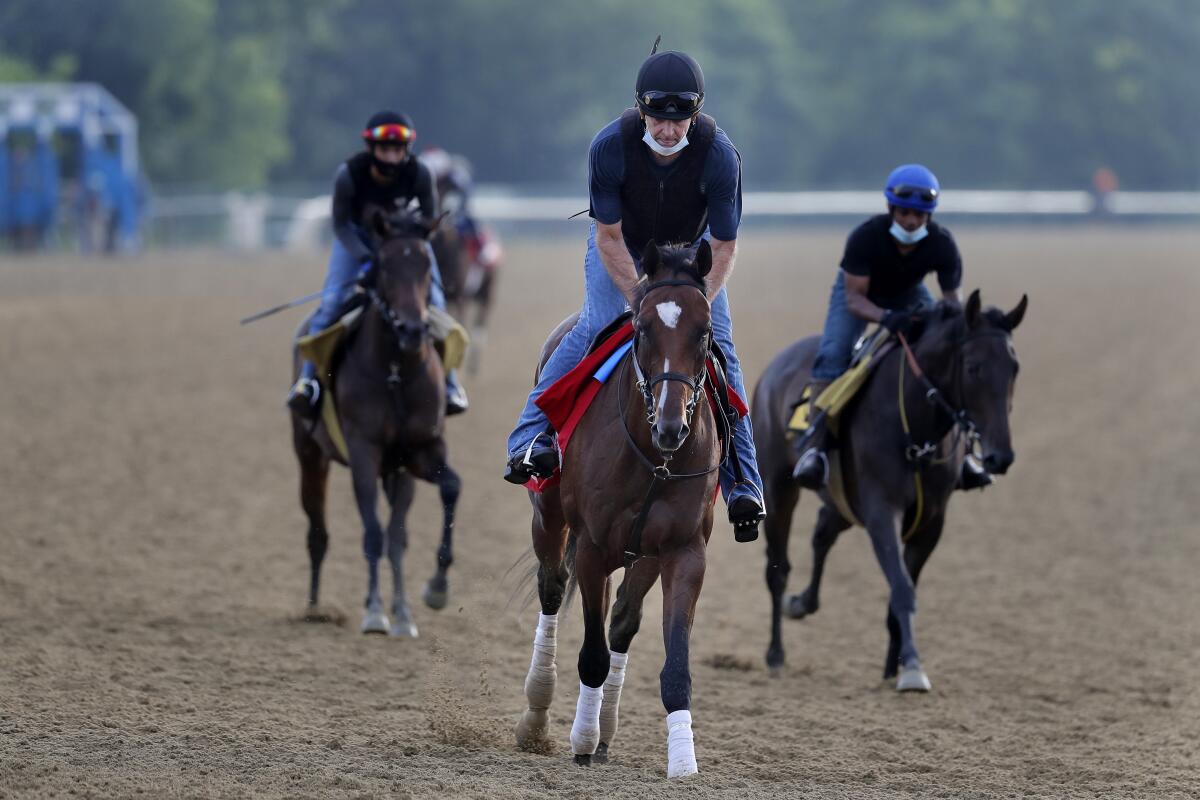Belmont Stakes lacks star power as horse racing embarks on a jumbled Triple Crown

- Share via
In the sports year of the asterisk, it is only fitting that horse racing has the usual third leg of the Triple Crown running first and that the longest race is now the shortest.
Saturday marks the 152nd running of the Belmont Stakes, traditionally the last of the Triple Crown races coming five weeks after the Kentucky Derby. It has been run at 1½ miles since 1926, but this year it’s much shorter at 1 1/8 miles and will use just one turn.
It also lacks the star power it once hoped for with top-rated Nadal going out with a career-ending injury and Charlatan getting a minor hoof injury that will keep him out through the 1¼-mile Kentucky Derby on Sept. 5. Both were based out of Bob Baffert’s barn at Santa Anita. Charlatan may be back in time for 1 3/16-mile Preakness on Oct. 3.
Another undefeated colt out of the race because of injury is Maxfield, who was considered in the top four along with Nadal and Charlatan. He was based out of Kentucky.
“It’s just been crazy,” said trainer Mark Casse, who will send Tap It to Win to post in the 10-horse field. “I’ve always said training race horses is like putting a puzzle together. This year, it’s like putting a puzzle together with no edges or a picture.
“I’m just happy that we’re going to have a Belmont and we’re going to have a Preakness, or at least I hope we’re going to have a Preakness, and the Derby. So whatever order it comes in, I’m fine with that.”
Trainer Todd Pletcher, who has won the Belmont Stakes three times and will send Dr Post and Farmington Road out on Saturday, certainly agrees that things are upside-down even though horse racing has been one of the few sports to remain active during the COVID-19 pandemic.
“I don’t think there is any question that at the end of 2020, you can put a big asterisk by the whole year, and the Triple Crown is certainly part of that,” Pletcher said. “It’s not going to be the same, it’s going to spread out over a much different time frame, and different distances and different orders. I think it goes without saying it’s a non-traditional Triple Crown series.”
The one horse that seems to be above the rest is Tiz the Law, the 6-5 morning-line favorite. He has won four of five races including two Grade 1s, the Florida Derby and Champagne Stakes, over this racing surface. No other horse in the race has won a Grade 1.
Tiz the Law is trained by Barclay Tagg, 82, and owned by Sackatoga Stables, the same connections that brought Funny Cide to the Belmont Stakes in 2003 after winning the Kentucky Derby and Preakness. Funny Cide finished third in the Belmont.
“Barclay has been in this game for 50 years, and he has all the experience you need,” said Jack Knowlton, the operating manager of Sackatoga Stables. “Barclay doesn’t get the kind of horses like Funny Cide and Tiz the Law very often. When he does get the opportunity, he makes the most of it.”
Tiz the Law is coming off an 11-week layoff, but his workouts have been sharp.
“He’s a nice horse. Hopefully he’s as good as we think,” Tagg said. “You work every day seven days a week and you just hope nothing happens and nothing goes wrong. But so far, so good. … We’re ready for the race.”
Trevor Denman, who has called every Del Mar race for 36 years, has informed the track he’s staying in Minnesota this summer because of the COVID-19 pandemic.
There is only one Southern California-based horse in the race, and that was a late decision. Fore Left was supposed to go in the seven-furlong Woody Stephens Stakes at Belmont, but with the Belmont Stakes field not that deep, Doug O’Neill, along with other trainers, is taking a shot. Even an eighth-place finish in the $1-million race pays $20,000.
“It’s on all of our bucket lists, and [owners] Paul and Zillah [Reddam] are pumped to have a horse good enough to compete,” O’Neill said. “More than anything, we’re just listening to the horse, and he’s showing us that he’s ready.”
Keeping a horse sharp for up to five months is a difficult task, making the likelihood of a Triple Crown winner less than in a traditional year. Still, winning one of the races is the ultimate resumé builder, especially when it’s time to become a stallion.
“I don’t think it would take away from the accomplishments of a single horse if they were able to win, one, two or three legs of it,” Pletcher said. “These are still very difficult races to win, but it’s clearly not the same as trying to do it all in five weeks at three different distances, culminating with the mile-and-a-half in the Belmont.”
More to Read
Go beyond the scoreboard
Get the latest on L.A.'s teams in the daily Sports Report newsletter.
You may occasionally receive promotional content from the Los Angeles Times.












